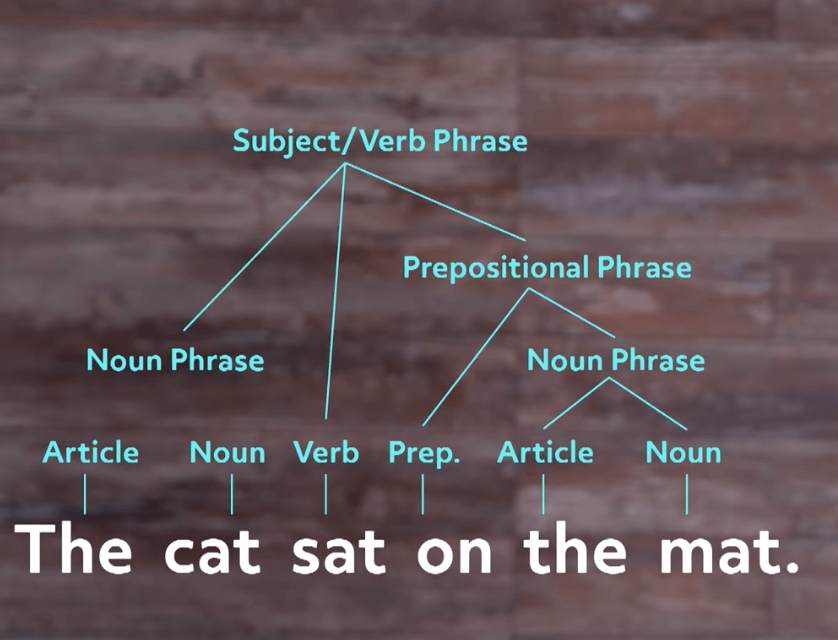Syntax is something we use everyday, whether we are writers or not. In everyday speech and across all languages, the way we order words in a sentence dictates how the sentence will be understood by others. How does this affect your writing? Keep reading to find out.
Define Syntax
First, let’s define syntax
Sometimes confused for semantics or even diction, syntax is one of the backbones of grammar. Let’s take a deeper dive into the syntax definition, learn the syntax rules, and really pin down what it is to have strong syntax in writing.
SYNTAX DEFINITION
What is Syntax?
Syntax is the order of the words in a sentence. The term can be applied to how clauses, phrases, and qualifiers are ordered.
Types of Syntax:
- Simple sentences
- Complex sentences
- Compound sentences
- Compound-Complex sentences
In grammar, syntax is the driving force behind the structure of our sentences; certain words tend to go in certain places to be best understood by others who speak a given language.
Syntax vs. Diction
For this reason, people often confuse syntax with semantics and even diction.
Semantics describes the understood meaning of the words in the sentence, while diction is the particular word choice within the sentence.
Let’s take the sentence, “To avoid getting wet, Richard brought a large umbrella and ran to and from the car.”
If we were to change the diction, we could say, “To avoid getting drenched, Richard brought a massive umbrella and sprinted to and from the car.”
If we were to change the syntax, it could look something like this: “Richard brought a large umbrella and ran to and from the car to avoid getting wet.” Same words, different order.
For clarification, syntax is English is taught as such:
SUBJECT + VERB + OBJECT > The cat climbs the tree.

Common English Syntax
What is Syntax
Syntactic Rules
Syntax refers to the basic building blocks of how we communicate as human beings. While people can express themselves with language however they see fit, there are certain syntactic rules that are rarely broken. Here are a few of the key rules for English syntax.
Sentences Need a Subject and Verb
What’s wrong with this sentence? “Walked to the dog park.” We don’t know who or what went to the dog park. How about this sentence? “Rishi the dog park.” Well, it’s just a collection of nouns and a definite article (the).
For a sentence to be a sentence, it requires a subject and a verb. Combining the information from the examples we have above, the full sentence would be, “Rishi walked to the dog park.” Here, we have a subject (Rishi) and a verb (walked).
This sentence also includes an object (the dog park) but that’s not necessary for it to be complete. “Rishi walked” is a perfectly acceptable full sentence.
Subject-Verb-Object
In English, this is the typical order of a sentence. Take the sentence, “Johnny drank wine.” Johnny is the subject, drank is the verb, wine is the object.
If we mix it up, it doesn’t make sense. “Wine drank Johnny.” Nope. “Johnny wine drank.” Not quite. “Wine Johnny drank.” You get the point.
One Sentence = One Idea
Generally, it’s best for a sentence to have one idea. With multiple ideas, it can be a good idea to split them up into multiple sentences.
Let’s take this as an example: “Jeremy ate food, I sat at the DMV.” As it is, this sentence is a run on: there are two complete thoughts that are incorrectly joined by a comma. We could correct it like this: “Jeremy ate food. I sat at the DMV.”
But this rule isn’t etched in stone. We can join the two ideas with a conjunction. Take the previous sentence in context: “I remembered I had an appointment to renew my license, so I left Jeremy at the restaurant. Jeremy ate food and I sat at the DMV.” Now the second sentence feels more cohesive, and is joined with “and.”
Adjective and Adverb First
In English, adjectives and adverbs go before the word they are describing. For example: “Smelly Billy-Joe angrily threw out the new deodorant.” If we put the adjectives and adverbs second, it’d look like this: “Billy-Joe smelly threw out angrily the deodorant new.”
Kind of poetic, but not grammatically sound.
Dependent Clauses Need Subjects and Verbs, Too
Just because a dependent clause is dependent doesn’t mean it doesn’t need a subject and verb. In fact, it does need a subject and verb.
So what separates a dependent clause from an independent clause (a sentence)? It’s not a complete thought.
A dependent clause: “Because Xiu ran away.” We have a subject (Xiu) and we have a verb (ran), but the thought’s incomplete. What happened because Xiu ran?
If you’re still a little murky on dependent vs. independent, have no fear– we’re about to delve deeper.
Explore Syntax
Types of Syntax
We briefly mentioned types of syntax in the definition section, but let’s define them further.
For more on all these types, check out our article on sentence structure.
Simple
Sometimes it’s best to keep it simple. A simple syntactic structure is just a single independent clause.
Take this sentence for example: “Tom went home.” It’s a full thought with a subject and verb. But a simple sentence doesn’t always look so simple. “Tom, Harry, and Jean all decided to walk over to Tom’s massive house” is a much longer sentence, but still a single independent clause.
Compound
A compound sentence contains two independent clauses, joined with a conjunction or a semicolon.
An example: “Kathy felt sick all day, but she continued to work on her physics project.” There are two clauses here which could be their own sentences: “Kathy felt sick all day” and “She continued to work on her physics project.” They’re put together with the conjunction “but.”
Complex
A complex sentence makes use of that dependent clause we were talking about. It combines dependent clauses with an independent clause.
Here’s an example. “Since Bob was shy, he went to the prom alone.” “Since Bob was shy” is dependent, and “he went to the prom alone” is independent– it could be its own sentence.
Compound-Complex
Compound AND complex? In this economy? That’s right folks. A sentence can have multiple independent clauses and a dependent clause, making it compound-complex.
An example of such a monstrosity: “After they failed their project, Daniel wept for forgiveness and Kyle denounced Ms. Klempt as a tyrant.” Can you spot which clause is which? “After they failed their project” is dependent, while “Daniel wept for forgiveness” and “Kyle denounced Ms. Klempt as a tyrant” are independent.
What is Syntax
Syntax Examples in Literature
Because syntax is the arrangement of words and phrases, every sentence ever written is an example of syntax. But let’s look at some examples from successful authors, and see what about their syntax works so well.
Underworld, Don DeLillo (1997)
“He speaks in your voice, American, and there’s a shine in his eye that’s halfway hopeful.”
DeLillo’s magnum opus sets out to chart the trajectory of America through the 20th century, and the first sentence of "Underworld" makes these intentions very clear.
DeLillo immediately implicates the reader with his syntax. Think of how much less impactful the sentence would be if it were, “There’s a shine in his eye that’s halfway hopeful, and he speaks in your voice, American.” It’s sacreligious to even write out!
Frankenstein; or, The Modern Prometheus, Mary Shelley (1818)
“The world was to me a secret, which I desired to discover; to her it was a vacancy, which she sought to people with imaginations of her own.”
Here, Mary Shelley uses a semicolon to directly compare the traits of two characters. The parallelism (to me, to her) drives the comparison home.
The Dog of the South, Charles Portis (1979)
“When the beer came, I dipped a finger in it and wet down each corner of the paper napkin to anchor it, so it would not come up with the mug each time and make me appear ridiculous.”
Charles Portis was the master of deadpan humor, and this sentence from "Dog of the South" is no exception. Imagine if the syntax were different, and Portis wrote, “So the beer would not come up with the mug each time and make me appear ridiculous, when it came I dipped a finger in it and wet down each corner of the paper napkin to anchor it.” The humor is deflated.Explore Syntax
How to use syntax in writing
Syntax is not necessarily a stand alone grammatical function. In fact, it ties into other key rules of writing that can seriously impact the strength and quality of your writing.
One key to efficient, coherent writing is use of active voice. While passive voice has its place in writing, active voice best reflects English syntax structure. This is because a reader can more easily confuse the subject and object in a sentence when the sentence structure does not follow common syntax rules.
Therefore, in addition to its often awkward nature, passive voice can muddle an otherwise clear and even exciting sentence.
The term syntax may be foreign, but in practice most unusual syntax is easy to spot. A clear cut and even celebrated example is Yoda’s particular phrasings.
Typical English Syntax: You are in grave danger.
Yoda Syntax: Grave danger you are in.
Typical English Syntax: I will meditate on this.
Yoda Syntax: Meditate on this I will.
Many who have studied Yoda’s syntax describe it as an Object - Subject - Verb order, which allows for a fantastical syntax.
However, depending on how simple the sentence is (or isn’t), even Yoda will switch back to typical English syntax on occasion.
Yoda in Typical English Syntax:
- “Pass on what you have learned.”
- “Do not assume anything.”
- “The fear of loss is a path to the Dark Side.”
Recapping Syntax
Syntax is the order of words in a sentence which we solidify when learning a language. If you like to play with syntax, remember the elements of syntax as well as these helpful tips:
- Subject + Verb + Object is the typical English syntax formula
- Use active voice
- If your subject is plural, your verbs should be plural too
- Get to the point; the quicker you can get to your point, the better
Up Next
How to use Active Voice?
In writing, it is crucial to be familiar with both "voices." Now that we have covered the syntax, let's tackle the active voice. Its function, how it works, and when it should be used.
